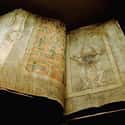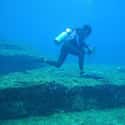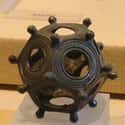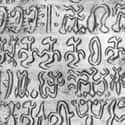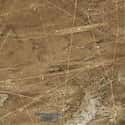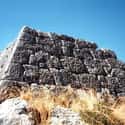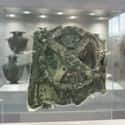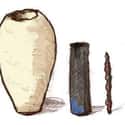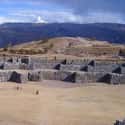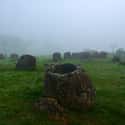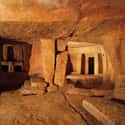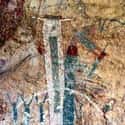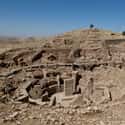-
(#1) 'The Devil's Bible'
Also referred to as the Codex Gigas, the Devil's Bible is a massive medieval tome, written in the 13th century by a monk who was said to have made a deal with the Devil in order to finish it. According to legend, the monk had been sentenced to be walled-up alive as punishment for breaking his vows. He promised the monastery that if they let him live, he would write a book that would contain all human knowledge - in a single day. To fulfill this promise, the monk sold his soul to Lucifer.
The real basis for this legend is likely the fact that even though the manuscript is extremely long, it appears to have been written by just one person over a relatively short period of time.
Created using more than 160 animal skins, and requiring two people to even lift it, the Codex Gigas contains the complete Latin translation of the Bible, as well as multiple other texts, including works by Hippocrates and Cosmas of Prague - not to mention medical formulas, texts on exorcisms, and a large depiction of the Devil himself.
Twelve pages of the original manuscript are missing, and what they might have contained remains a mystery - some rumors say those pages contain secret Satanic texts, perhaps even a method for conjuring the Devil himself.
-
(#2) The Nazca Lines
Most people are likely aware of crop circles: sprawling, circular patterns often made in the cornfields of farmers throughout the world that are said to be created by extraterrestrials. They're possibly a form of communication, possibly a warning. But perhaps the most fascinating of these types of symbols, dubbed geoglyphs, are the Nazca Lines found across the dry, desert plains of southern Peru.
Said to be created by the Nazca culture between 500 BCE and 500 CE, there are more than 100 of these massive glyphs, depicting everything from simple lines, to intricate designs of monkeys, humans, fish, jaguars, and birds. Although the symbols are recognizable, the true purpose of these glyphs is unknown. Some say the lines were created as a means of giving incoming sailors directions. Others say they were used for astronomical purposes, as a way to signal the stars.
-
(#3) The Underwater Ruins Of Japan
Submerged just off the coast of Yonaguni Jima is Japan's own Atlantis, a sprawling underwater city believed to be at least 5,000 years old. First discovered by a diver in 1995, the city was initially believed to be nothing more than a bizarre series of natural rock formations, all of which mysteriously featured perfect right angles and straight lines. Later searches revealed everything from a large stone gateway to carved stairways and streets to vaulting towers.
Believed to be the former city of the Jomon people, experts theorize that the city didn't exactly "fall" into the sea like the fabled Atlantis, but rather became submerged as sea levels rose over thousands of years. As scientists continue to research the underwater site, many believe this particular site could hold key information to other possible underwater cities around the world.
-
(#4) Roman Dodecahedrons
Unlike many other ancient artifacts, there are actually about a hundred of these mysterious objects floating around. Typically made of either stone or bronze, the hollow Roman dodecahedrons have 12 sides, with a small circle on each, and pegs jutting out from the connecting corners.
Although they resemble nautical devices, the purpose of these dodecahedrons is unknown. Historians have guessed everything from fortune tellers to candleholders. Some say they were used for astrological or religious means. Experts have dated them as far back as the 2nd and 3rd centuries CE, and suggest they were used to sow winter grains, or even to calibrate water pipes for Roman architects.
-
(#5) The King List
Going all the way back to the 3rd millennium BCE is the Sumerian King List, a listing of all Sumer kings, their respective dynasties, locations, and times in power. While this may not seem like too much of a mystery, it's what is inscribed along with the list of kings that makes it so interesting.
There are mythological elements embedded within it. Along with a who's-who of Sumerians in power, the King List also incorporates events such as the Great Flood and the tales of Gilgamesh, stories that are often referred to as simple fables. Theorists take this to mean that the Old Testament stories were true, or that the kings listed were actually gods or demi-gods.
-
(#6) Easter Island's Rongorongo Writings
Easter Island has many strange mysteries associated with it, and the large moai statues are the most famous. However, some people that the entire island was once used by extraterrestrials as a means to communicate as well. But there is still another strange mystery linked to the famous Polynesian lands - an intricate series of glyphs believed to be writing or proto-writing, an earlier form of communication based on symbols rather than characters.
First discovered by Eugene Eyraud in 1864, the glyphs are said to go back to around 1200, and feature imagery similar to that of other religious signs found in the area. To date, scientists have not been able to determine exactly what the glyphs say or link them to any outside cultures. The symbols were carved on wood using small obsidian flakes or shark teeth. Assuming that Rongorongo is indeed a form of writing, it would be a fascinating example of an entirely unique language that formed independently by itself on an isolated island.
-
(#7) The Sajama Lines
Western Bolivia's Sajama lines are a series of massive drawings etched into the earth, numbering into the thousands. First discovered in 1932 by Aimé Felix Tschiffely, the lines, between 3 to 10 feet wide individually, connect about 8,700 square miles via an intricate web-like design. Because of this, they are not only the largest archeological site in the Andes, but possibly in the entire world.
The question remains: what is the purpose behind these mysterious lines? Scientists have deduced they were originally created by the indigenous people who lived near the Sajama volcano, but for reasons unknown. Some have speculated they were used for religious purposes.
-
(#8) The Hellenikon Pyramid
While it's fairly common to label the Egyptian pyramids the stuff of "ancient mysteries," it's something entirely new to discover similar structures all around the world. Such is the case with the Pyramids of Argolis, Greece, and their most famous structure, the Hellenikon Pyramid.
The true purpose of the Hellenikon remains unknown, although experts have theorized that a battle once took place at the site, and the structure was subsequently built as a monument to those who died - although nothing has been found within the pyramid's walls to provide evidence of an actual tomb.
While the mystery of what's inside the Hellenikon is certainly intriguing, what truly fascinates theorists is the fact that it was supposedly built in 2720 BCE - making it significantly older than any of the Egyptian pyramids.
-
(#9) The Antikythera Mechanism
At some point between 70 and 60 BCE, a Greek ship heading from Asia Minor to Rome sank in the Mediterranean. When a group of sponge divers discovered the wreck in 1900, they salvaged three pieces of bronze comprising a device that became known as the Antikythera mechanism.
The artifact, which is roughly the size of a shoebox, puzzled scholars for more than a century, largely because the sophistication of its gears and internal workings are far beyond any known Greek technology of the time. In fact, the Antikythera mechanism has long been a favorite of fringe academics claiming it as evidence of alien visitations in ancient history.
X-rays of the artifact in the late 20th century revealed, however, that it is designed to track astronomical movements. The finding was confirmed by 2006 CT scans revealing inscriptions that are instructions for what is, functionally, an ancient computer. While its use as an astronomical measure is no longer mysterious, the Antikythera mechanism's singularly advanced construction and precision still pose questions about Greek technology.
-
(#10) The Baghdad Batteries
In 1838, while working in what is now Iraq, German archeologist Wilhelm Konig found a number of clay jars, each containing an iron rod encased in a copper cylinder. Konig published a paper in which he theorized the objects were ancient batteries, or galvanic cells. That would be an amazing technological development, given the age of the objects - they date to the Parthian era, or about 200 BCE. According to Elizabeth Stone, a leading authority on Iraqi art and archeology, experts don't subscribe to the battery theory.
An alternate theory suggests the containers were used for storing scrolls, which would have wrapped around the iron rod, and been contained in the copper cylinder. This theory has its roots in the Seleucia vessels, similar objects from a nearby ancient city.
Despite the opposition to Konig's theory, Smith College Art History professor Dr. Marjorie Senechal had students build replicas of the device, which produced voltage. If they were batteries, they worked. Theories as to what such a battery would've been used for range from medicinal practices to printing money, creating metal plating, and making jewelry.
-
(#11) The Giant Stone Spheres Of Costa Rica
Since the 1940s, archeologists have been unearthing mysterious stone spheres in the Diquis Delta of Costa Rica. Initially discovered during agricultural forays undertaken by the United Fruit Company, these objects range in size from a few centimeters to over two meters in diameter with some weighing as much as 16 tons. All of the spheres are man-made objects formed from the igneous stone known as granodiorite.
Although many of the structures have been transported to various high profile locations in Costa Rica or are owned privately, their origin in the Diquis Valley remains unexplained.
-
(#12) The Bog Bodies Of Northern Europe
Since the 18th century, hundreds of incredibly well-preserved human cadavers have been discovered in the peat bogs of Northern Europe. These bodies have been forensically dated to as far back as 8,000 BCE. The famous "Tollund Man," discovered in 1950 by two Danish farmers in a small town in Denmark, lived in the Pre-Roman Iron Age of the 3rd century BCE. He was so well preserved that the contents of his stomach were used to establish when he lived.
Despite the different demographic makeup of these corpses in terms of age, sex, and social standing, there is one mysterious and unexplained commonality in their composition. They seem to have been deliberately executed and placed in the bogs, with no explanation as to why this method of disposal would be utilized. Researchers speculate that perhaps they were sacrifices or social outcasts.
-
(#13) Cuzco's Saksaywaman Fortress Walls
Outside of Cuzco, Peru, you'll find a remarkable walled fortress constructed out of perfectly fitted boulders, some weighing over 200 tons. Known as Saksaywayman, the exact construction date is unknown, although the structure is ancient enough to predate the Incas themselves.
While the function of Saksaywayman as a fortress and a ceremonial location is well documented, the process of how this massive fortification was constructed is still not understood. The gaps between the rocks are so thin that a piece of paper will not even fit between them - engineering that required a massive amount of manpower and technological expertise to assemble.
No one has determined how this process was accomplished although theories abound. Some people believe that a liquid extracted from plants rendered the boulders lighter and more malleable, or that heat allowed the rocks to be forced together. Others think that the building was constructed from a complicated wooden template.
-
(#14) Laos' Plain Of Jars
In the northern Xieng Khuang province of Laos, a bizarre collection of large circular objects dot the countryside. Believed to be over 2000 years old, the best guess concerning the function of these cylinders located on the Plain of Jars is that they had some role in an ancient funeral rite.
Constructed of sandstone and weighing at least a ton, these objects reside in an area which suffered greatly during the American "Secret War." Many of the cylinders were damaged or shattered by missiles. Today, visitors are not allowed to visit most of the ancient sites, which have not been cleared of active cluster bombs.
-
(#15) Malta's Hypogeum Of Hal Saflieni
The Hypogeum of Sal Saflieni was not even discovered until 1902. Perhaps initially a sanctuary and ultimately a burial place of some kind, the Hypogeum is the only preserved example of subterranean labyrinth architecture in Europe. In use from 4000 to 2500 BCE, the structure has three levels that are painted with ornate designs and architecture carved out of the rock.
The most mysterious aspect of the edifice is a special chamber, known as the "Oracle Chamber," in which words spoken at a normal volume are amplified a hundred times and audible throughout the entire structure. Whether this design feature was intentional and how it was used is unknown.
-
(#16) North America's White Shaman Rock
In the Lower Pecos River Canyon in southwestern Texas, a 4,000-year-old rock painting has mystified archeologists. Known as the "White Shaman Rock," the 24-foot cave painting has been interpreted as a depiction of warriors in battle as well as a recreation of tribal members interacting with the spirit world after using peyote.
The ancient drawing is one of the numerous cave paintings in the area attributed to the Huichol tribe, a group of hunter-gatherers who avoided contact with European settlers based on their remote Sierra Madre mountain habitat. No one is exactly sure what role these paintings played in tribal life or what they even depict.
-
(#17) Turkey's Göbekli Tepe
In 2008, Klaus Schmidt discovered a site in Turkey that is believed to be the first temple ever assembled by mankind. Known as the Göbekli Tepe, this massive carved stone structure date backs to 11,000 BCE and predate Stonehenge by 6,000 years. The temple was built before the advent of metal tools or even pottery.
Essentially a set of T-shaped pillars and stone rings, these structures are adorned with crude drawings of various animals including lions and spiders. The site has already provided new information about the formation of societal evolution. But what exactly those drawings mean and the specific function of the temple is still undetermined.
New Random Displays Display All By Ranking
About This Tool
History has left us with both earth-shattering legends and confusing mysteries, attracting generations of people to study the truth and search for answers. Humans are naturally curious. Mysteries excite all of us, and we are always eager to solve them when we happen to encounter them. For centuries, people have been exploring the mysterious events of the past, but there are still some unsolved mysteries that plague archaeologists and scientists.
From where Cleopatra’s mausoleum was to who built Stonehenge in England to the truth of the Trojan War, even if people already have advanced archeological techniques, they still cannot know these truths. The random tool lists 17 incredible unsolved ancient mysteries in the world.
Our data comes from Ranker, If you want to participate in the ranking of items displayed on this page, please click here.











